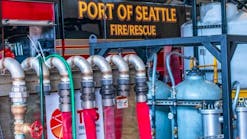“You've got about 60 to 90 seconds before that fire burns to that fuselage,” said Ronald Krusleski, senior captain, assistant ARFF coordinator, for the City of Houston Fire Department in reference to the Aeroflot Flight 1492 crash in Moscow on May 5, 2019. “Thank God that aircraft rescue events are not happening every day, but we really have to prepare for that,” he continued.
Ed Martin, airport operations manager for Coastal Carolina Regional Airport (EWN), described how right away a fire on the airfield will be different than that of a structural one.
“I would say the biggest difference is when we respond to an aircraft mishap, it's likely going to be a fuel fed fire if there is a fire. So that presence of flammable hydrocarbon is the biggest challenge and the biggest difference, I think, as compared to fighting a structural fire out in town,” Martin said.
Jack Bermingham, senior product manager for Oshkosh Airport Products, elaborated further: “ARFF is particularly unique due to the mass casualty risk when a plane incident may occur at an airport. An aircraft fire is considered a class B fire due to the large amount of jet fuel onboard. The class B fire risk results in our customers requiring Oshkosh to design in class B foam systems and dry chemical powder systems. The ARFF response is set up to provide as much of these firefighting agents to the aircraft incident as quickly as possible to minimize the impact.”
Fuel isn’t the only thing firefighters have to consider when responding to an incident. The layout of planes leads to there being a lot of obstacles in the way for firefighters and escaping passengers to navigate, from seats to spilt luggage.
The unique challenges ARFF presents require equally unique equipment. ARFF vehicles are designed to even the odds between fuel and flame, and man and time – with pump and roll.
“Probably the most important thing, in my opinion, is the capability for mass application of foam combined with pump and roll,” said Duane Kann, East Coast ARFF sales manager for Rosenbauer and retired fire chief of the Orlando International Airport. “Structural apparatus have to be stationary when they're put into the pump mode. ARFF vehicles are designed to start pumping agent while the truck is approaching the incident. The truck can articulate around the scene while continuing to discharge foam on the fire. So being able to pump and roll is a huge benefit to the ARFF firefighting world.”
At the Gary/Chicago International Airport, spokesperson for the airport Adam Gypalo, said the airport has a 2001 Oshkosh TI-1500 ARFF with a High Reach Extendable Turret (HRET); a 2003 Oshkosh Striker 1500, with piercing nozzles; and various extinguishers and other standard firefighting equipment tools for individual use.
Gypalo said that the airport will soon be looking to make some upgrades.
“We anticipate replacing the bulk of our wheeled equipment in phases over the coming years as they reach the end of their lifespan. While we perform regular maintenance to ensure the equipment remains in strong operational condition, we follow FAA-mandates for equipment replacement to ensure we remain up to date on best practices,” said Gypalo.
Martin said they too are in the process of replacing their vehicle.
“Our biggest piece of equipment is our rescue vehicle. It's an E-ONE TITAN truck, but it's about 15 years old. It's in good shape, but we're actually in the process of bidding for another truck right now,” said Martin.
All About the Money
There are two factors that impact what equipment an airport’s ARFF team will have. The first is meeting the minimum requirements of their administrative bodies, as well as the needs of their unique layouts and considerations.
“Airports set minimum firefighting capability needs based off ICAO, FAA, and NFPA requirements. The different requirements allow for airports to customize their fleet based on their runway layouts to optimize the response at their airport,” said Bermingham. “In the 21st century, airports are also mini cities that include a wide variety of other fire response scenarios including parking garages, terminal EMS and fire response, fuel farms, and aircraft refueling operations to name a few. Each airport assess their ARFF response and additional airport fire response needs to design a fleet to meet their unique needs.”
Oshkosh’s sales team partners with their engineering staff to work out any unique requirements and ensure they can design in features for specific airports.
Kann points out, though, and even more important factor is going to be an airport’s funding source.
“The funding stream is going to be one of the most important factors in determining how they want to move forward shopping for their ARFF equipment,” Kann said.
There are three main ways an airport can fund it’s ARFF equipment, through Airport Improvement Program (AIP) grants from the FAA, the use of Passenger Facility Charge (PFC) money and then self-funding.
AIP and PFC funding each have to follow the FAA advisory circular 150/5220-10E.
“That circular actually has a template depending on the class ARFF unit that the airport is purchasing, class four, class five, or class one, two, or three. There is a template that allows them to pick and choose certain items on the vehicle that are approved for FAA funding,” Kann explained. “They specifically, in that FAA advisory circular, outline what is allowed and what's not allowed to be purchased.”
“That circular actually has a template depending on the class ARFF unit that the airport is purchasing, class four, class five, or class one, two, and three. The template allows airportsto pick and choose certain items on the vehicle that are approved for FAA funding,” Kann explained. “The advisory circular, basically outlines what is allowed and what's not allowed to be purchased with FAA funding.”
That circular provides a template of specs, based on the National Fire Protection Association (NFPA) 414 document, which airports can then choose from. For airports using AIP funding, that is all they can use with one exception. The AIP Handbook was updated in 2014 and provides some additional details not consistent with the advisory circular that went into effect back in 2011. The AIP Handbook lists several details for ARFF vehicles that should also be followed when using AIP funding. The good news is some of these items are above the minimum items allowed in the advisory circular. This can be a bit confusing because they are a little contradictory of each other, such as allowing and not allowing radios to be included in the base vehicle specification. The FAA is in the process of updating the advisory circular to the 150/5220-10F version. It is important for airports and ARFF departments to provide feedback during the open comment period that should be announced later this year.
“Once the spec is done, the airports add their legal mumbo jumbo, hopefully without crossing the line and adding requirements like warranty, delivery or training requirements that are all outlined in the advisory circular, and that's what they can release out to bid, and the low bidder is awarded based off of that base vehicle specification only,” Kann said. “Optional items, extended warranties, and other extras can be added to the bid package, but they must be separate from the base vehicle bid price and cannot be used as part of the bid award determination.”
The next step up then is PFC funding, which follows the same advisory circular as AIP funding, but offers greater flexibility.
“They don't just have to go with the low bid project award. They can use other means. They can use cooperative purchasing agreements, or they can add different criteria that they use as a part of their normal purchasing practices to purchase the vehicle, as long as the vehicle specs follow the advisory circular, because again, that's federal funding and FAA only funds the items that are in the advisory circular,” Kann explains.
Escaping the stringency of federal funding are airports who fund their ARFF equipment themselves and, as such, dictate their own needs.
“If they're using their own funding, it's wide open. They can make the requirements whatever they want to make them,” Kann said.
It’s a funding source typically utilized by bigger airports, Kann said, but notes that it’s not always the case, as when he was the fire chief at Orlando International Airport, they used AIP funding. Kann added that once airports get into the lower indexes, they’ll most likely be using AIP funding.
“The vast majority use the AIP funding because it's free money, it's grant money and it's eligible for ARFF vehicles,” he said.
And while the money’s free, there are two pitfalls airport can fall into with it. The first is an airport not properly following the bidding model, causing them to have to restart the process over – a far too common issue, Kann said.
“The airport can't add things to award determination criteria like extended warranties, vehicle inspections and additional optional equipment, but they get themselves in trouble doing that all the time. The rules are pretty easy and the template makes it very clear, but they still try to add extra stuff and get it for free,” Kann said.
The second difficulty arises when airports end up with ARFF trucks from different manufacturers, causing firefighters to have to memorize several different controls and adding an additional layer to their thought process when responding to a crisis.
“Fleet consistency has also alleviated a lot of the implementation concerns as firefighters and maintenance personnel will be more familiar with a specific vehicle’s operations,” said Bermingham. “Airports should also consider the long-term history of their selected manufacturer as the costs of operating an ARFF vehicle is not just the upfront investment but also the total cost of ownership through the entire service of the vehicle.”
“One of the biggest challenges with AIP and PFC funded ARFF vehicles is the fact that each time a truck is bid, they have a potential to have a different manufacturer win that bid process,” Kann said. “One of the things we hear is that airports and firefighters want to try to maintain the same brand of vehicle whenever they can.” “There’s a lot of importance there because in an emergency situation, the firefighters need to have their abilities be second nature. They can't take long to think, they just have to be able to react. It has to be muscle memory. And, those types of things are difficult to have when you have three different types of trucks where their turrets work differently and a lot of things about each truck is different. So, having the consistency in fleet is a very important piece that all firefighters would tell you is extremely important.”
To avoid this, Bermingham said airports are increasingly using their own funds to purchase ARFF vehicles, rather than seeking grants to purchase their vehicles.
“This trend stems from airports wanting and needing to commonize their fleets to ensure operators and maintenance personnel can leverage the commonality to reduce training on multiple platforms and ultimately optimize efficiency,” he said.
More to It Than a Truck
Staying well trained and staying fresh for incidents that might be a once in a lifetime event is a daily priority, Larry Lippel, battalion chief for the Charlotte County, Fla., Fire Department, said.
“The biggest thing with ARFF is to, I think, keep our firefighters engaged, because you're constantly doing training and you may not have an incident,” he said. “Keep it fresh, but still emphasize the priority you need to get out there, you need to maintain the familiarization, you need to go out there and drive the hangers, see the aircraft, understand what your apparatus will do.”
Lippel’s crews are able to rotate off of the airport for fire duties, keeping their firefighting skills sharp as the combat fires and respond to emergencies off the airfield so their ready for when an accident occurs on it.
Gary/Chicago International Airport has taken other steps to ensure their ARFF optimization, having recently transitioned city firefighters with their own staffed crew.
“Since the official transfer, we are now training personnel under our own operational jurisdiction. We have developed an enhanced curriculum that encompasses both firefighting and operations, and we have been recruiting college graduates with educational background in aviation and airport management to ensure we have the most effective personnel available to meet our needs,” said Gypalo.
In Wyoming, Casper/Natrona County International Airport is in the process of constructing a new ARFF training facility.
“Right now, our facility doesn’t offer any training for interior fires or wheel fires. The new facility will allow us to simulate a fire in the cockpit, cabin, gallery, overhead compartment, APU and any combinations. The new facility will also allow us to train students wheel and engine fire techniques. Students will be able to experience fire scenarios with actual liquid fuel. With the facility upgrade the Airport will be acquiring a new Oshkosh Striker 3000 with a High Reach Extendable Turret (HRET). The facility will have a HRET prop allowing the Airport to train departments that have HRET operations,” said Aaron Buck, the Airport’s Deputy Director, Operations & Public Safety.
At EWN, Martin said they are constructing a 4.9 million dedicated ARFF facility that will include a training room.
“It'll be a dedicated facility for our trucks. It'll have two bays, it'll have a training room and all the associated components to support our training,” said Martin. “It'll have doors on both ends, so the truck can drive through the bays, if necessary. It'll have storage racks for our as SCBAs and for our firefighting bunker gear that we need to have. It will have the capability of serving as an emergency operation center, if necessary. We'll also do some ancillary things in there that administratively help support the firefighting mission. The way our situation is today, things are dispersed. In the future, we'll have a consolidated site where all those activities can take place.”
Making sure firefighters have the time to get to know a vehicle, Kann noted, is an important part of what Rosenbauer as a manufacturer ensures takes place whenever they sell an ARFF truck.
“Training is not the proper word, it is actually vehicle familiarization. That's the requirement manufacturers must accomplish to ensure firefighters are familiar with their new vehicle. We all do that, and that does include some level of training, but in the end, the department has the responsibility to continue training on their own. Larger departments usually have a training officer that has a dedicated training program, but smaller departments might just have one person assigned to that ARFF station each day. There's plenty of them out there. Either way, the firefighters have to go spend a few hours on that vehicle every day, practicing and playing with it to make sure that they can get comfortable to the point they're actually proficient,” said Kann.
Simulations using and getting familiar with an ARFF truck’s ability to pump and roll is an important aspect to the process Bermingham added.
“The ARFF training simulators use various fuel sources to create actual fire for ARFF firefighters to train and learn how to put out. Airports are also utilizing ARFF specific computer simulators to aid in firefighter driving and fire scenario training. Oshkosh has various offerings of computer simulators that utilize actual switch, button, and joystick parts from the Striker to provide a real-life scenario that can minimize wear and tear on vehicles due to training,” he said.
Of course, being familiar with a vehicle isn’t all there is to it. An airport must also make sure their trucks are up and running – a daily task.
“A firefighter checks out their apparatus every day. Every morning, first thing they do is they go out and check operational readiness. We also have two dedicated mechanics. They go in and do the annual preventative maintenance. We have 15 heavy duty apparatus and it takes two days or more to do a preventative maintenance on them, and they do that at least annually,” said Krusleski.
Krusleski added that the fire department is lucky to be able to have mechanics who are solely dedicated to their trucks. It’s no good if the response to an emergency is stalled by a dead battery, after all.
“They're made by humans, things are going to happen, but it's not going to happen because we're not prepared. It's not going to happen because we didn't check them out. It's not going to happen because we didn't do preventative maintenance. It's going to happen because it just broke. It's not going to be because we were negligent in checking it out,” Krusleski added.
Lippel, too, said that preventive maintenance is key to a successful operation.
“Our county has an outstanding preventative maintenance program with our emergency vehicle technicians, our PM service. The trucks are brought frequently, there's no delay on getting them in to get the preventative maintenance work done,” said Lippel. “The trucks are checked out each day and logged. Once a week, the trucks are gone through from bumper to bumper, not only clean, but then check them further.”
A New Place to Train
In Appleton, Wis., a state-of-the-art ARFF training facility is opening its doors to students this summer. In a partnership between the Appleton International Airport (ATW) and the Fox Valley Technical College (FVTC), the facility is the center of FVTC’s new ARFF training programs – which will begin welcoming veterans looking for ARFF refreshers and those new to the ARFF world this summer.
The facility features a Boeing 777 training prop, a Cessna Firehawk training prop and an actual Boeing 727, with the former two being used for live fire training and the 727 being used for hands-on training.
Program instructor Ben Sokol, who has 19 years of experience in emergency services including ARFF, said FVTC is offering two programs. The first and primary program is an introduction course and training to the basics of airport firefighting, with the second program a driver/ operator course teaching how to use ARFF vehicles. Both courses are 40 hours.
We are offering two main 40-hour courses, Airport Firefighter, which is an initial Aircraft Rescue Fire Fighting course and Driver/Operator ARFF. Both classes can be taken concurrently in our ARFF Academy. We also offer Part 139 annual live fire training as well as customized training to meet ARFF department’s needs.
“Our airport firefighting class covers all the FAA-required topics and it includes the live fire training, split between classroom and hands-on. The hands on portion of the training includes both live fire training as well as training with the 727 that we have here on the grounds” Sokol said.
For the driving class, Sokol said the trainings center has a simulated airfield for students to operate on as if it were the real thing.
“It's going to play out very similarly to driving on an airfield, complete with signage that looks like it's on an airfield. We have an instructor playing the part of the control tower so that the students will have to request clearance,” Sokol said.
Sokol added that they will be offering other classes, such as part 139 refresher classes and standalone live fire training, in addition to customizable training.
“If your fire department has 25 firefighters that you need to get trained, we can come up with what you want your annual refresher training to encompass,” Sokol described. “How much time do you want to spend on the truck? How much time you want to spend doing different styles of burns? We have a lot of different options with our training ground.”
Live fire training one the 777 and Cessna props will include everything from ground fires, such as simulating a fuel spill, to cabin fires, cockpit fires, galley fires and wheel fires.
“We can run pretty much run any fire scenario that a fire department might have to deal with,” added Sokol. “And then we have the 727 parked out there. It's an actual aircraft, so the seats are in there, you go into the cockpit and all the buttons and switches are there for students to practice with. I think we left no stone unturned in putting this thing together.”
The facility and training program have been years in the making, with the seeds for the facility being planted in 2012, said Abe Weber, ATW’s airport director. That’s when ATW and FVTC partnered to develop a public safety training center on the airport’s property – a 75-acre training facility featuring law enforcement, firefighting and EMS facilities.
“And then fast forward to 2015, we learned the ARFF Training Center in Duluth, Minnesota was closing. So, our airport and the Fox Valley Technical College Public Safety Training Center staff put a business plan together to approach the FAA to construct a regional ARFF training center here,” Weber recounted. “We really felt we could add onto the facility already in place at half the construction cost of anywhere else and still create a state-of-the-art facility for the Midwest and all of the U.S.”
ATW and FVTC worked closely with the FAA, Wisconsin Bureau of Aeronautics and engineer Omni Associates to bring the facility to fruition.
“We went to the FAA multiple times with our business plan. They helped us develop it. It was essentially 2014-2015 until 2018 before we realized we could move forward, a good three year process,” Weber said. “It was developing the business plan to ensure it would stay viable for 20 plus years. Ensuring that we fully understood the market for both commercial and non-commercial airports. What classes we were going to offer. What price point we were going to be able to offer classes at. What the entire facility would be comprised of. What components we would seek to construct.”
Another partner in helping get the facility off the ground was the Oshkosh Corporation, whose close proximity to ATW and FVTC made their involvement with the program a no-brainer.
“They're bringing in hundreds of firefighters every single year to look at new ARFF trucks and to inspect their ARFF trucks and purchase new ARFF trucks. So we think this was a great local partnership as well for us providing this ARFF training center where, if you're buying a truck from Oshkosh Corporation, you can test it out in a real world scenario before taking it home to your fire department or take it home to your airport. You can test all the brand-new bells and whistles at our training center which I think is an awesome scenario to have. It's like buying a sports car and then having the test track right next door to it, right?” Said Weber.
FVTC’s program will utilize a 2019 Oshkosh Global Striker with high reach extendable turret.
Construction on the facility has been completed and classes are, currently, slated to start June 1. Sokol said classes will typically enroll six students, especially given the COVID-19 pandemic and stress on social distancing, with one instructor for classroom work and three instructors for hands-on training.





